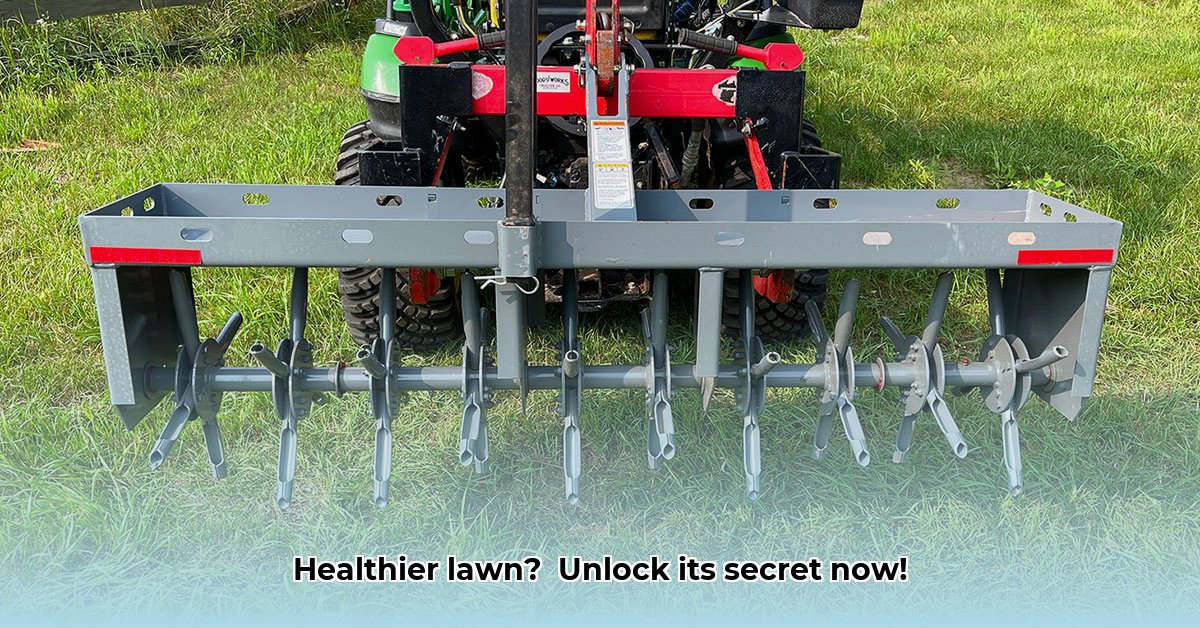
Tired of a struggling lawn? Even with diligent watering and fertilizing, does your grass still look patchy and unhealthy? The secret to a vibrant, green lawn might lie beneath the surface: healthy soil! Soil aeration is the key, and Tractor Supply offers a range of lawn aerators to help you achieve a lush, thriving lawn. This guide will explain why aeration is crucial, help you choose the right aerator, and walk you through the process step-by-step – all while focusing on sustainable lawn care practices. For those with John Deere tractors, check out these John Deere aerator options.
Why Aerate Your Lawn? The Foundation of Sustainable Lawn Care
Think of your lawn's soil as a sponge. Compacted soil is like a squeezed-dry sponge, unable to absorb water and nutrients effectively. This leaves your grass roots starved, leading to weak, unhealthy growth and susceptibility to disease. Overwatering and over-fertilizing become necessary, harming both your wallet and the environment.
Aeration—the process of creating channels in the soil—is the solution. It allows air, water, and nutrients to reach the grass roots, fostering stronger, more resilient plants. This translates to a greener, healthier lawn that requires less water and fertilizer, aligning perfectly with sustainable practices. Did you know that properly aerated soil can retain up to 20% more water than compacted soil? This significantly reduces your water consumption and environmental impact.
Dr. Emily Carter, Soil Scientist at the University of California, Davis, states: "Aerating your lawn is a fundamental step in sustainable lawn care. It improves soil structure, reducing the need for excessive watering and chemical fertilizers."
Types of Lawn Aerators at Tractor Supply: Choosing the Right Tool
Tractor Supply offers various lawn aerators, each suited to different lawn sizes and soil conditions. The two main types are:
Spike Aerators: These are budget-friendly and easy to use, ideal for smaller lawns with lightly compacted soil. They create small holes by puncturing the soil. However, they don't remove soil plugs, limiting their effectiveness on heavily compacted areas. Think of them as a quick fix for minor compaction.
Core Aerators: These are more powerful and effective, removing small cores of soil to create larger channels. This significantly improves aeration and drainage, making them ideal for larger lawns and heavily compacted soil. While more expensive upfront, the long-term benefits outweigh the costs through reduced water and fertilizer needs.
Choosing Your Aerator: Matching Your Needs
Choosing the right aerator depends on several key factors:
Lawn Size: Spike aerators are suitable for smaller lawns (under 2,000 square feet), while core aerators are better for larger areas.
Soil Type: Heavily compacted clay soil benefits greatly from core aeration. Lighter, sandy soil might only need spike aeration.
Budget: Spike aerators are less expensive than core aerators. Motorized core aerators are the priciest but offer the least physical exertion.
Physical Ability: Manual core aerators require considerable physical effort. Consider a motorized option if you have limited physical strength or a large lawn. A rhetorical question to consider: Is your back up for the task of manual aeration across a sizable yard?
How to Aerate Your Lawn: A Step-by-Step Guide
Follow these simple steps for optimal results:
Preparation: Mow your lawn to a shorter height (around 2-3 inches) and remove any debris. This ensures smooth aerator penetration.
Aeration: Follow the manufacturer's instructions carefully. For core aerators, overlap passes by at least 50% to ensure complete coverage. Maintain a consistent pace and pressure with spike aerators.
Post-Aeration Care: Water gently after aeration, avoiding heavy watering that might wash away soil plugs. Give your lawn a few days to recover before resuming other lawn care activities, such as mowing or fertilizing. Allow time for the created channels to settle and begin their work.
Maintaining a Healthy Lawn: Sustainable Practices Beyond Aeration
Aeration is only one part of a holistic, sustainable lawn care approach. Consider these additional practices:
Watering: Deep, infrequent watering encourages deeper root growth, leading to a more drought-tolerant lawn.
Fertilizing: Opt for organic fertilizers to improve soil health naturally, promoting a thriving ecosystem.
Mowing: Follow the correct mowing height for your grass type, and avoid scalping.
Remember, a healthy, sustainable lawn is a beautiful lawn!
Conclusion: Invest in a Healthier, Happier Lawn
By choosing the right lawn aerator from Tractor Supply and employing these sustainable practices, you can transform your lawn's health and appearance. Investing in soil aeration is an investment in a healthier, more vibrant, and environmentally friendly lawn – a testament to your dedication to both aesthetics and sustainability.